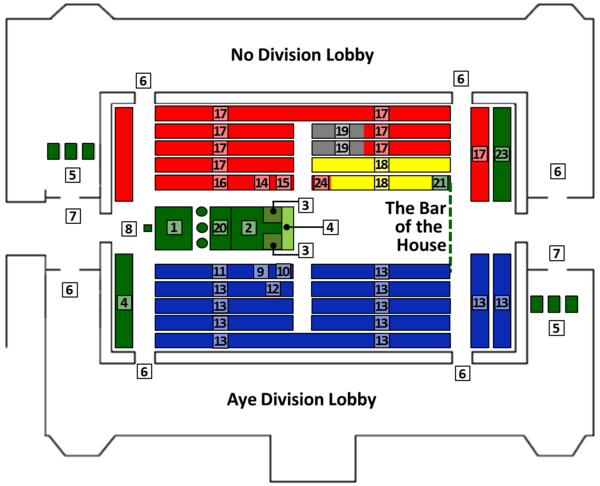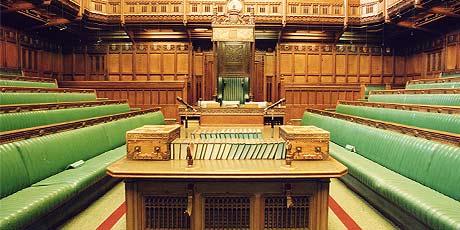Commons Chamber
For information about the procedures and make up of the House of Commons, please see House of Commons.
The place where the best kind of reality TV happens. MPs come to the chamber to make speeches, represent their constituents, support their leaders, vote through laws and generally make a lot of noise.
History[edit | edit source]
The Fire and Sir Charles[edit | edit source]
On 16 October 1834 a fire ripped through Parliament and burnt down a lot of the old buildings, including the Commons. The fire was started through the "over-enthusiastic" stoking of the furnaces beneath the House of Lords with tally sticks (hazel sticks on which the amount of tax due from an individual was recorded; the stick could be split to provide a demand and a bill - or receipt).[1] A competition to design the new Palace had 97 entries. Number 64, the design by Sir Charles Barry, was the winner. The House of Commons first sat in their new Chamber in 1850 but did not move in their full time for another two years.
World War Two[edit | edit source]
The Commons Chamber was all but destroyed by the bombing in 1941 and a new Commons Chamber was built following the end of the war. It took five years to build, and the Commons first sat in their new Chamber, designed by Sir Giles Gilbert Scott, on 26 October 1950. Because the country was poor after the war (and various other socio-politco-economic reasons that won't be gone into here), Britain asked the countries of the Commonwealth to help furnish parliament. The full list of contributions by Commonwealth countries can be found on the Parliament website here.
Layout[edit | edit source]

Seating[edit | edit source]
There are strict rules about where people get to sit in the House of Commons. The Government sits on the Speaker's right, the Opposition to his left, as you can see in the diagram above. Places within the Government and Opposition benches are determined by a Hobbesian battle royale in which persistence and the ability to wake up early in the morning are the keys to victory. The Commons Chamber has only 427 seats to house 646 MPs, so in packed debates like PMQs people have to sit on the stairs or in the second floor galleries, or stand behind the Speaker's Chair or the bar of the House. Even when there is enough room seating arrangements can bring acrimony and discord, as parties and MPs have favourite seats and bitter fighting can break out over who gets to claim the best spots.
Seating for each day is allocated at morning prayers, before the day's sitting officially starts. MPs who show up for prayers get to fill out a prayer card that they can slot into the card holders in the benches, reserving the seat for the day on a first come, first serve basis. You are not allowed to fill out a prayer card for someone else, move their prayer card, or photograph your prayer card in its holder with your smartphone so you can prove to any bastard who tries to steal your seat that you've reserved it. All these rules are regularly broken.
Benches[edit | edit source]
The Commons Chamber is laid out in an adversarial style, with the Government on one side and the Opposition on the other. Some of the benches have special properties.
- The Treasury Bench: So named because the Prime Minister is the First Lord of the Treasury, the Treasury Bench is where the Government sits, right behind the Government despatch box. During important debates it is usually packed full of Cabinet ministers, and during departmental questions it holds the Secretary of State and their junior ministers. The presiding government whip usually sits on the edge farthest from the Speaker.
- The Opposition Frontbench: Directly opposite the Treasury Bench, the Opposition Frontbench seats the top brass of Her Majesty's Loyal Opposition, ie. the main opposition party. They usually mirror the Government, so in important debates you get the whole Shadow Cabinet and in departmental questions you get the shadow team for that department plus a few random people who hang around to lend moral support.
- The Awkward Squad Bench: When the Tories are in opposition the second front bench on the Opposition side is the territory of the leaders of the second largest opposition party, as you can see in the diagram above showing the layout in the 2005-2010 Parliament. When Labour are in Opposition it is the territory of Dennis Skinner, and woe betide any who try to take it from him. The corner nearest the Speaker's Chair is a prime heckling location and it has been his spot in Opposition for 45 years. He fought David Owen for it. He will happily fight you. Don't mess with him.
- The Nutvies Bench: Nutvies like to sit on the backmost bench behind the Treasury Bench so they can shoot rubber bands at ministers' heads and cuddle together without anyone noticing.
- Jacob Rees-Mogg's Lounge Chair: Jacob Rees-Mogg has no yet caught up with sixth century chair technology, and is still operating on the Roman reclining system. To facilitate this, he needs somewhere with an armrest where he can sprawl and still face the Chamber. His favourite seat is therefore the third row back on the Government benches opposite the Awkward Squad.
Speaker's Chair[edit | edit source]
The Speaker gets their own chair. Deputy Speakers get to sit in the big fancy chair when they are acting as Speaker.
On the back it has a bag full of petitions to Parliament which no one ever reads. Every few months they empty the bag and then start collecting some more petitions to ignore. It is sometimes suggested that the petitions bag is the point of origin for the phrase to have something "in the bag" but the former clerk sir Robert Rogers says this is complete rubbish and that he gets really annoyed with people spreading the false story.
Table of the House of Commons[edit | edit source]
In the middle of the Chamber, between the Opposition and Government front benches, is the Table of the House of Commons. As a table generally should, it also has stuff on it.
The Table[edit | edit source]
The morocco-bound volumes between the two Despatch Boxes are largely decorative. They are Acts of Parliament between 1981 and 1996. Also on the Table, in green slip-covers, are copes of Erskine May, Dod's Parliamentary Companion, Vacher's Guide, the Standing Orders and the Register of Members' Interests.[3]
Despatch Boxes[edit | edit source]
The Despatch Boxes are made of the New Zealand wood pururi.[4]
On the Government side, the Despatch Box has copies (in English, English Braille, Welsh, Gaelic and Cornish) of the Oath of Allegiance sworn by MPs when they first come into the House, and after each general election, and the Affirmation for those MPs who do not wish to swear. Also in the Despatch Box on the Government side is a New Testament, a Douai Bible, and an Old Testament.[5]
There is nothing in the Despatch Box on the Opposition side.[6][7]
The Mace[edit | edit source]
For more details about the Commons bling, please see Mace.
The big golden scepter is the Mace of the House of Commons, which represents the Queen's authority. Without it, Parliament can't legally sit.
References[edit | edit source]
- ↑ Rogers, R., 2009, Order! Order! A Parliamentary Miscellany. London: RJ Books
- ↑ E.g.Liberal Democrats, Ukip and the Greens
- ↑ Rogers, R., 2009, Order! Order! A Parliamentary Miscellany. London: RJ Books
- ↑ Rogers, R., 2009, Order! Order! A Parliamentary Miscellany. London: RJ Books
- ↑ Rogers, R., 2009, Order! Order! A Parliamentary Miscellany. London: RJ Books
- ↑ Rogers, R., 2009, Order! Order! A Parliamentary Miscellany. London: RJ Books
- ↑ You might think this is a metaphor for Opposition policy. We couldn't possibly comment.
